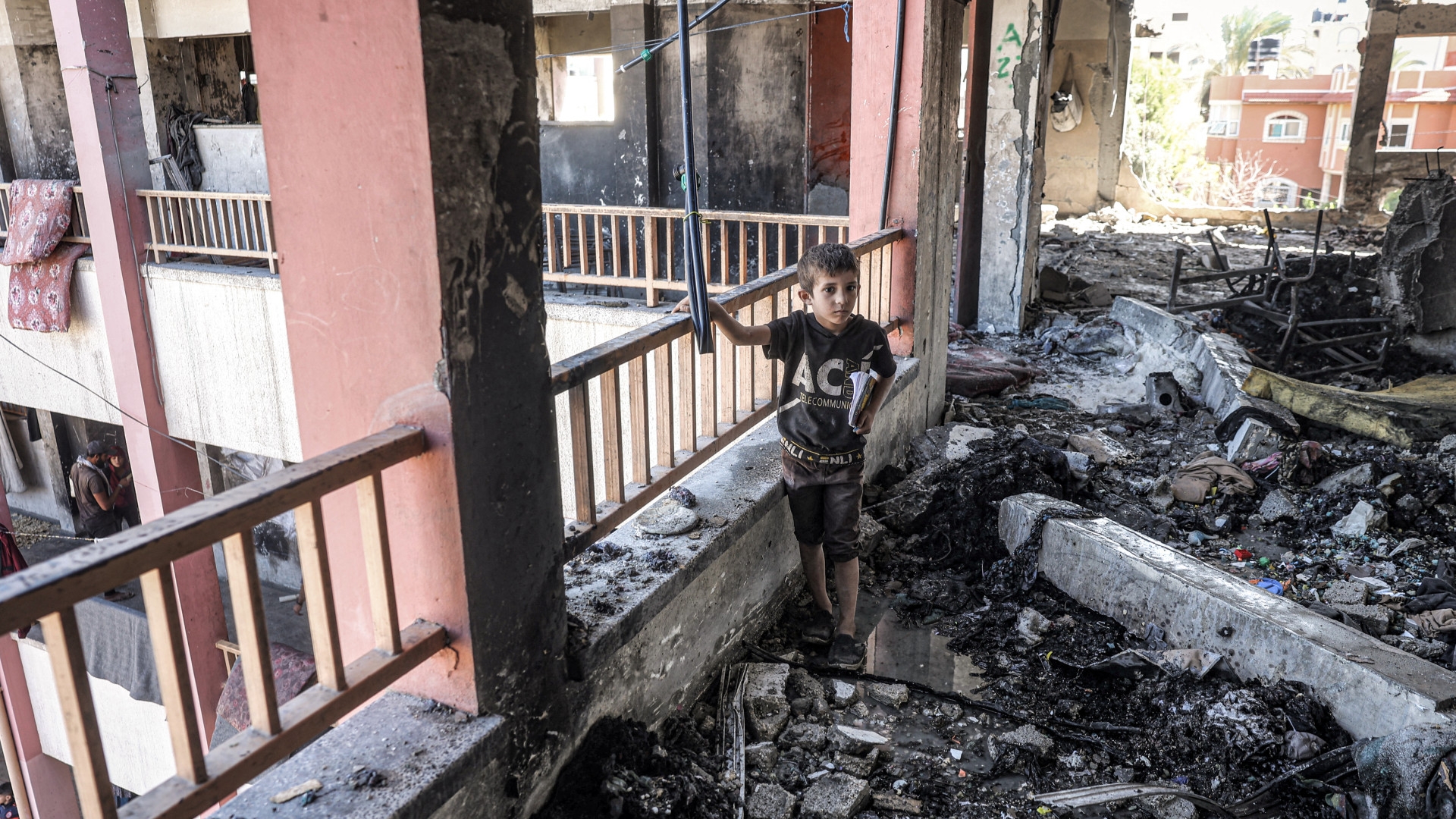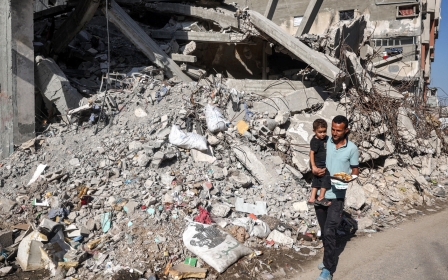Israeli atrocities are nothing new. The only novelty is the scale

The ongoing and simultaneous Israeli aggression in Gaza, the West Bank, Lebanon, Syria, Yemen, and Iran strikes many as exceptional and unprecedented.
Israeli attacks targeting civilian airports, hospitals, schools, and shelters are thought to be the work of an extremist right-wing leadership spearheaded by Prime Minister Benjamin Netanyahu that the country had never perpetrated before.
Likewise, settler violence across the West Bank and settler invasions of al-Aqsa Mosque are seen as novel provocations and violations that previous rational Israeli governments would have never allowed or at least sought to seriously limit.
But none of this is true.
While the scale of the genocide in Gaza - which has killed, according to recent estimates, around 200,000 people - is indeed unprecedented, such atrocities are routine in all Israeli governments.
New MEE newsletter: Jerusalem Dispatch
Sign up to get the latest insights and analysis on Israel-Palestine, alongside Turkey Unpacked and other MEE newsletters
Horrific precedents
Israeli Labor Party leaders committed similar Israeli war crimes and crimes against humanity, to which the people of the Arab world have fallen victim since the very founding of the predatory Jewish-supremacist settler colony.
There are several examples of such horrific precedents. After the 1967 war, Israel violently suppressed protests against its conquest of three Arab countries. The Israeli occupiers attacked people in Gaza, the West Bank, the Golan Heights, and the Sinai daily - shooting, killing, beating, and arresting them and destroying thousands of their homes.
In Ismailiyyah alone, between 1967 and March 1970, Israel killed 600 people and created almost a million refugees who fled the Suez Canal cities
The Israelis completely demolished Jerusalem's ancient Moroccan Quarter and went on to level entire Palestinian villages to the ground, including Shuyukh in the Hebron area, and Nusayrat and Jiftlik, among others, in the Jordan Valley.
They also attacked the villages of Banyas, Jibata, Kafr Harib, Nakhilah and others in the Golan Heights, all of which were destroyed in the last half of 1967 alone.
In the occupied West Bank, they went on to use chemical defoliants in 1972 in the village of 'Aqraba near Nablus, where they confiscated 100,000 dunums of land, leaving the Palestinian peasants with no more than 6,000 dunums.
As the Palestinians refused to sell the remaining land, an Israeli Piper plane sprayed their fields with the defoliants, destroying 200 hectares of wheat-planted lands to "teach a lesson to these villagers".
In 1972, Israel expelled 10,000 Egyptians in the occupied Sinai after confiscating their lands in 1969. The Israelis went on to bulldoze and destroy their homes, crops, mosques, and schools in order to establish six kibbutzim, nine rural Jewish settlements, and the Jewish city-colony of Yamit.
Massacring Arabs
In the meantime, the Israelis were busy bombing all the neighbouring Arab countries and committing massacres.
In November 1967, they bombed the Palestinian refugee camp in al-Karamah inside Jordan, including a girls' school. They killed 14 people, including three schoolgirls and a teacher. In February 1968, they bombed the camp again, this time hitting the boys' school, also killing another 14 people.
Israeli planes went on to napalm more than 15 Jordanian villages and refugee camps along the River Jordan, killing 56 people, 46 of whom were civilians. More than 70,000 people fled to Amman as refugees.
Follow Middle East Eye's live coverage for all the latest on the Israel-Palestine war
In June 1968, Israel lobbed rockets at the Jordanian city of Irbid, killing 30 people and napalmed the Jordanian town of Salt, killing another 28. In the last five months of 1969, Israel killed upwards of 69 Jordanians in bombing raids.
In February 1969, Israel also bombed Syria, killing nine civilians. These bombing raids targeted villages like Majdal Sallum, Maysalun, and Hasbaya and culminated in the Israeli bombing of seven Syrian villages, which killed 200 people in September 1972 alone.
Throughout this period, Israel was also busy bombing Egypt.
In September 1967, Israeli bombings killed 44 Egyptians in Port Tawfiq and Suez, and 36 more in Ismailiyyah. In July 1968, Israeli artillery targeted Suez again, killing 43 Egyptians. In Ismailiyyah alone, between 1967 and March 1970, Israel killed 600 people and created almost a million refugees who fled the Suez Canal cities. Israel then went on to bomb the Egyptian town of Mansurah, killing 12 people in March 1970.
But that was not all. The Israelis committed two of the worst massacres in February 1970, when they napalmed a scrap metal plant in Abu Za'bal, killing 70 workers, and in April 1970, when they bombed an elementary school in Bahr al-Baqar and killed 46 children.
Their raids on Lebanese villages increased in 1970, including on Kafr Kela and Bint Jubayl, killing dozens of civilians. Israeli air raids increased in 1972, particularly in February and September of that year, killing 58 civilians.
Lest we think Yemen escaped Israeli aggression, earlier in the 1960s, especially between 1964 and 1966, Israeli air force planes were busy flying over Yemen and dropping weapons and ammunition to the American, British, and Saudi-backed royalist forces against the republican revolutionaries in Yemen's civil war.
As for Iran, whose tyrannical Shah was a close ally of Israel, Israel had been aiding him in repressing the Iranian people in every way possible.
In August 1967, Israeli official documents aver that it "established a close, friendly, and practical partnership between the IDF and the security services and their Iranian counterparts, with joint execution of programs and missions of national importance, with continuous mutual visits by the heads of the armed forces and their senior officials".
Indeed, the Israelis would later train the repressive Iranian police in Israel and had a most intimate relationship with the notoriously cruel Shah's secret service, Savak, which was busy persecuting all Iranian dissidents.
Israeli belligerence
Like today, hospitals were always a favourite Israeli military target.
During Israel's brutal conquest of East Jerusalem in 1967, it deliberately bombed the Augusta Victoria Hospital with napalm, falsely claiming that it was being used by the Jordanian army, one of Israel's many fabrications. In 1982, it bombed the Gaza hospital in a Beirut refugee camp.
As for airports, Israel bombed the main civilian airports in Damascus and Amman during its 1967 conquest.
While Israeli attacks on the Aleppo and Damascus airports have not subsided over the last decade, this is hardly a new tactic.
Indeed, Israel bombed Beirut International Airport in December 1968 and destroyed 13 civilian passenger planes, worth almost $44m at the time, in addition to hangars and other airport installations. It also bombed the environs of Cairo International Airport in 1970.
In 1973, it downed a Libyan civilian plane, killing 106 passengers on board.
The above atrocity exhibition aims to demonstrate that the malevolence and violence that Israel has inflicted on the Palestinians, Lebanese, Syrians and Yemenis over the past year is no more than a continuation of its long-standing aggression against Palestinians, and Arabs more generally.
These atrocities were not committed by an extremist right-wing party, but by the so-called "progressive" Labor Party and its Prime Ministers Levi Eshkol, Yigal Allon, and Golda Meir.
The above details are just some of the atrocities that Israel committed over a short historical period - long before its current genocidal war. Of course, Israeli belligerence and the atrocities of its Zionist colonists go back to the inception of Zionist settler-colonialism at the end of the 19th century.
These atrocities were not committed by an extremist right-wing party, but by the so-called 'progressive' Labor Party
What the last year has demonstrated, however, is that the scale of Israeli destructiveness, and not the kind of atrocities, is what keeps mounting and increasing in leaps and bounds.
If the Zionists murdered 13,000 Palestinians in 1948, and Israel killed 18,000 Palestinians and Lebanese in 1982, its current genocide has increased the number of the annihilated Palestinians and Lebanese tenfold. It did not, however, change the nature of the settler-colony's aggressiveness, inhumanity, or strategies.
The only observable difference is that of degree, not kind.
Those who want to lay these crimes at the doorstep of Netanyahu or even his Likud Party should review some of this history to disabuse themselves of such delusions.
These war crimes are, in fact, a foundational strategy of the settler-colonial regime that has governed Israel since its establishment. The only novelty is the scale of the crimes, not their nature.
The views expressed in this article belong to the author and do not necessarily reflect the editorial policy of Middle East Eye.
Middle East Eye delivers independent and unrivalled coverage and analysis of the Middle East, North Africa and beyond. To learn more about republishing this content and the associated fees, please fill out this form. More about MEE can be found here.






